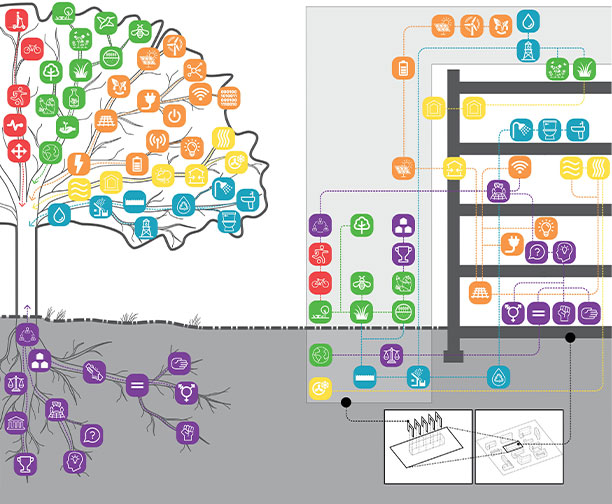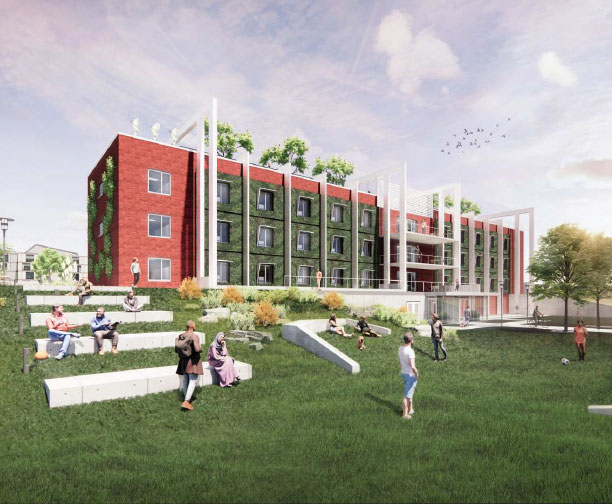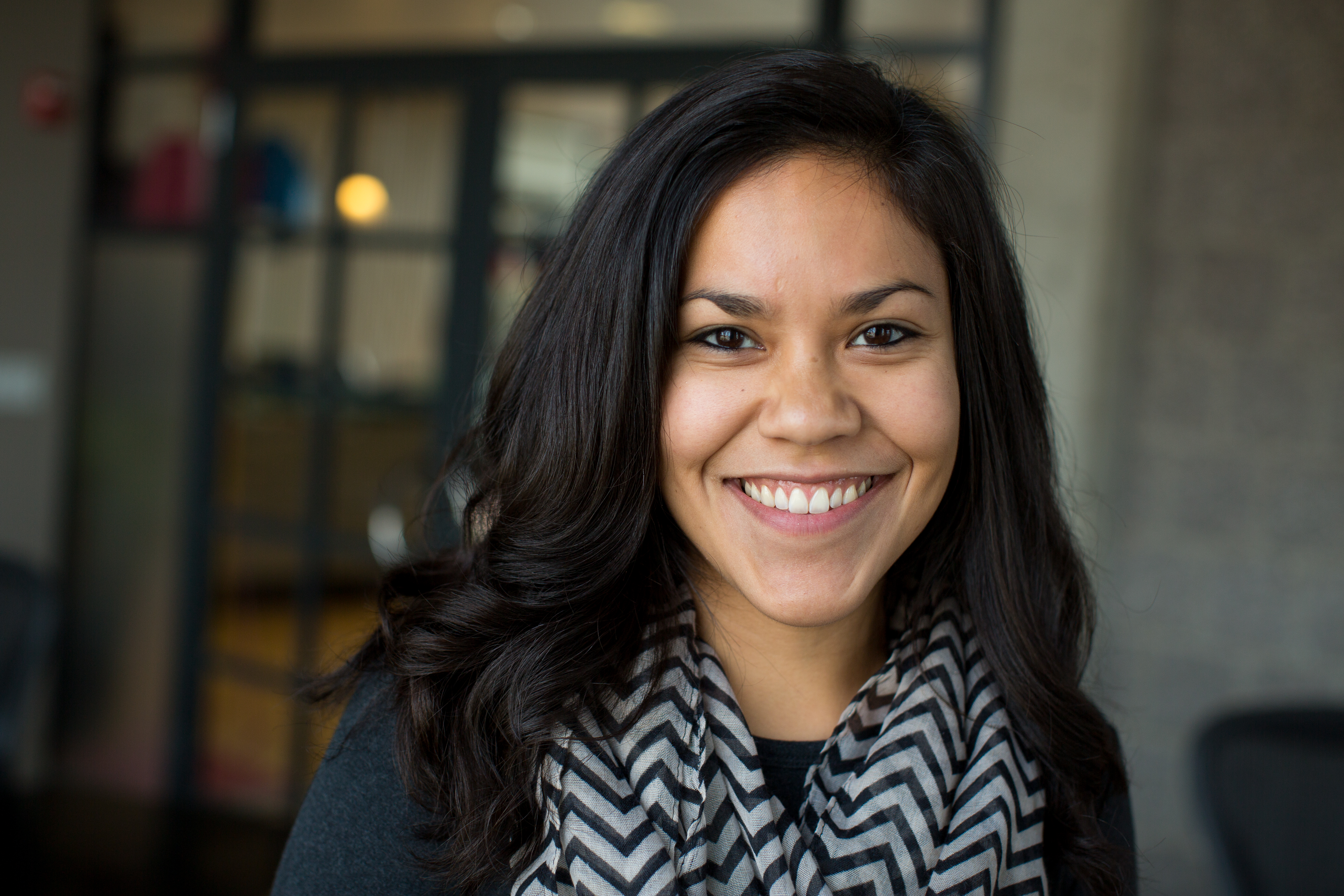A recent competition challenged architects to find creative new ways to improve buildings in a changing climate. Our entry tackled a structure found on almost every college campus. Here’s how we reinvented it.
By: Shawna Foley, RA // Project Architect
Alex Keiser // Project Associate
Ben Niebauer, RA, LEED AP BD+C // Associate Principal, Education Market Leader
John Ryan, AIA, LEED AP // Associate Principal, Project Architect
Deferred maintenance has been a common refrain for universities for at least a decade. And with new economic uncertainty fueled by a pandemic, these deferred needs…will likely be deferred again. With that in mind, DesignGroup recently entered a design competition that gave us a chance to explore new ideas for reclaiming outdated facilities — and answer an even greater need.
We love design competitions. They let us flex our creativity and share our work on an international stage. This summer, the Arch Out Loud organization hosted “WARMING: Architecture for a Changed World,” which tasked architects with a problem we’ll all face eventually: the environmental results of climate change. Like rising sea levels. Higher temperatures. And smog-choked cities. Our entry applies green solutions to buildings in desperate need of updating.
You might be surprised by the whimsy and invention that comes out of a challenge like this. WARMING is a serious competition about a serious issue that…doesn’t take itself too seriously. Imagine energy-capturing wind turbines on the Eiffel Tower. Or giant inflatable water barriers surrounding the Sydney Opera House. Those are just two of WARMING’s own ideas to inspire the entrants.

We chose to focus on the university residence hall (or “dormitory,” in by-gone days), a staple of mid-20th century collegiate architecture. This building type was so common it seemingly rolled off conveyor belts onto campuses around the country, with little thought for the lives that would be lived within them. Utilitarian and bland, the embodied energy of these buildings is massive. In the interest of preventing a Warming Climate, why not take a deeper look at this common, but unnoticed building type and find ways to improve its performance?
We’re really proud of our entry, because it applies audacious changes to something easily overlooked. While others were focused on stadiums and business towers, we chose something much humbler and more practical —with lots of potential for improvement. Here’s what we did.
Brick Box Redux
Brick Box Redux is a reinvention of these ubiquitous, banal brick dorms. They were made with the same cheap, common materials and standard, simple details in virtually every climate and space, whether urban or rural, coastal or arid, temperate or frigid. And yet the form is so poorly designed it’s often barely inhabitable. In the winter months, dorm room windows are propped open to let off excess heat from an overzealous boiler. In the summertime, a façade of window-shaking air conditioning units can barely keep up with the demand for cooling and comfort.
We found many ways to improve its performance. Our scheme proposes a set of interchangeable solutions that can be implemented individually or holistically for local climate needs. Our design provides not only a climate resilience, it also fosters social resilience, which deepens connections between campus and the community.

Seed Armatures
One need look no further than our deciduous trees for models of systemic symbiosis. They receive sunlight and carbon dioxide, produce air, food, building materials, cooling, homes, and more. They give more than they take. By planting new “seed” armatures around our existing buildings, we can imbue them with the same abilities to provide more than they consume, and spawn change in societal, resource, and energy practices. Where better than the bastions of free thinking that are our colleges and universities to plant these seeds of change? This diagrammatic point of departure illustrates the different systems, concepts, and methodologies capable of being supported by such interventions.

The plan emphasizes the ground floor program and the social connections that are fostered across campus and throughout the community. Solid lines indicate circulation patterns with a specific purpose or transaction; dashed lines indicate freeform travel and interaction between the college and society.
Programmatic color overlays imbue each space not just with a functionality, but a sustainable purpose. In particular, orange is an indicator for building systems and operation, which include a solar hot water thermal system, greywater cisterns, and per-floor submetering to enable sustainable competitions amongst the occupants of the building.

Features for the Future
The concept arms these places with tools for efficiency in a warming climate. Key elements include the living green wall panels, sun shades, earth mounds providing thermal mass and dynamic spaces, and helix turbines making use of the wind diverted by the building form.
Large structural frames host a variety of sustainable features including green ledges and photovoltaic arrays. At the roof and second floor levels, green roofs and garden spaces provide students an intimate connection with nature, as well as an apiary and garden on the western portion of the roof.
A retrofit scheme for insulating the enclosure from the inside greatly improves the efficiency of the envelope and thermal retention. Around the base of the design, programmable alcoves are created by the structural frames. These spaces include a bocce court, pocket park, exterior cafe seating, and planting beds.

What better opportunity is there than a competition to evaluate new design ideas and opportunities? What better opportunity than a pandemic, when the pace of business and construction has slowed, to ponder our existing buildings and re-envision them for the future?
This project has been nominated for an AIA Pittsburgh People's Choice Award - Vote here!
Winners of WARMING 2020 will be announced next month.
Meet the Team:

Shawna Foley, RA // Project Architect
Shawna believes that good design plays an important role in creating a sense of community and identity within a place. She brings lots of passion and fresh ideas to the table in her role as Project Architect. She views architecture as a vital tool to effect positive, large-scale impact on both the project and community level. Shawna strives to execute her work by collaborating with colleagues to the highest standards of the profession, achieving or exceeding client expectations.

Alex Keiser // Project Associate
Alex is a 2020 graduate of the Stuckeman School of Architecture at Penn State University. In addition to his studies, he served as the Director of the PSU Digital Beehive software group providing training to students on architectural programs and technology. Alex has joined DesignGroup as a full-time employee this year following his internship with us last summer.

Ben Niebauer, RA, LEED AP BD+C // Associate Principal, Education Market Leader
Ben leads DesignGroup’s education practice. He has focused his 18 year career on exceptional design and planning for academic facilities. Ben has significant experience designing student centered environments including health science facilities, laboratories, over 5,500 student housing beds, and has assessed and planned 30 million square feet of higher education campuses. Ben is an active participant with the Society of College and University Planners.

John Ryan, AIA, LEED AP // Associate Principal, Project Architect
John practices architecture as a collaborative process, engaging with the client, user groups, stakeholders and other project partners to discover the project solution. His experience includes a range of building types, including civic, healthcare, higher education and commercial projects. Common to each of these projects is the use of design as a tool for engagement, conversation and problem solving for the entire design team. John’s interest in wellness design stems from his interests in environmental and social sustainability, and his belief that design can yield powerful results for the integration of built and natural environments, as well as strengthen the social fabric of our cities and communities.
